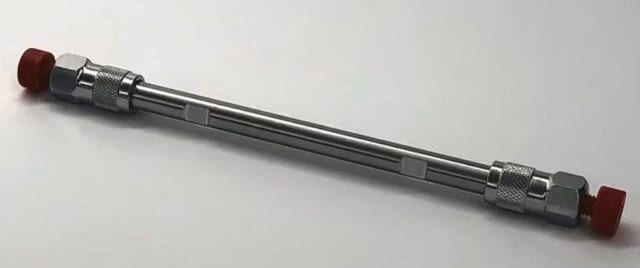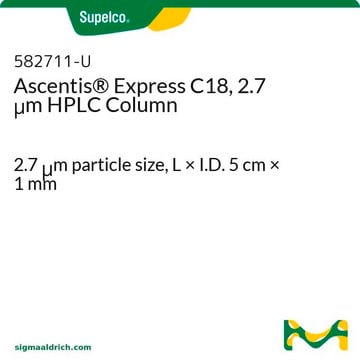The Guide to Dispersion Measurement has simple instructions on how to measure IBW and can be found at sigma-aldrich.com/express.
Kluczowe dokumenty
53569-U
Ascentis® Express 90 Å F5 (2.7 μm) HPLC Columns
L × I.D. 10 cm × 2.1 mm, HPLC Column
Synonim(y):
Core-shell (SPP) Fused Core PFP HPLC column
Wybierz wielkość
3730,00 zł
Wybierz wielkość
About This Item
superficially porous particle
3730,00 zł
Polecane produkty
Nazwa produktu
Ascentis® Express F5, 2.7 μm HPLC Column, 2.7 μm particle size, L × I.D. 10 cm × 2.1 mm
Materiały
stainless steel column
Poziom jakości
agency
suitable for ISO 21675 2019
suitable for USP L43
linia produktu
Ascentis®
Właściwości
endcapped
producent / nazwa handlowa
Ascentis®
opakowanie
1 ea of
Parametry
60 °C temp. range
600 bar max. pressure (9000 psi)
metody
HPLC: suitable
LC/MS: suitable
UHPLC-MS: suitable
UHPLC: suitable
dł. × śr. wewn.
10 cm × 2.1 mm
powierzchnia
135 m2/g
zanieczyszczenia
<5 ppm metals
Matryca
Fused-Core particle platform
superficially porous particle
grupa aktywna macierzy
PFP (pentafluorophenyl) phase
wielkość cząstki
2.7 μm
wielkość porów
90 Å pore size
pH robocze
2-8
Zastosowanie
food and beverages
metoda separacji
reversed phase
Szukasz podobnych produktów? Odwiedź Przewodnik dotyczący porównywania produktów
Opis ogólny
Zastosowanie
- Interference of Preservatives on Urinary Iodine Measurement by Sandell-Kolthoff Method.: This research examines the impact of preservatives, including hydrochloric acid, on the accuracy of urinary iodine measurements. The study highlights the need for careful selection of preservatives to avoid analytical interference (Kaya et al., 2022).
- Monitoring the Extraction of Copper from Chicken Dung Leachate Using an Aluminium Electrode as an Indicator.: The study explores the use of hydrochloric acid in the leaching process of copper from chicken dung. It demonstrates the effectiveness of hydrochloric acid in extracting metals from organic waste materials (Kugeria et al., 2019).
- Development of an Analytical Method for Urocanic Acid Isomers in Fish Based on Reactive Extraction Cleanup and Chaotropic Chromatography Techniques.: This paper details a method using hydrochloric acid for the extraction and analysis of urocanic acid isomers in fish. The method enhances the detection and quantification of these compounds in biological samples (Zhong et al., 2018).
- Determination of Single-Ion Activities of H+ and Cl- in Aqueous Hydrochloric Acid Solutions by Use of an Ionic Liquid Salt Bridge.: The research provides a novel approach to determining the activities of hydrogen and chloride ions in hydrochloric acid solutions using an ionic liquid salt bridge, contributing to the understanding of ion behavior in aqueous solutions (Sakaida et al., 2011).
Informacje prawne
Nie możesz znaleźć właściwego produktu?
Wypróbuj nasz Narzędzie selektora produktów.
Zastosowanie
kartridż do prekolumny
produkt powiązany
wymagane, ale niedostarczone
Kod klasy składowania
11 - Combustible Solids
Klasa zagrożenia wodnego (WGK)
WGK 3
Temperatura zapłonu (°F)
Not applicable
Temperatura zapłonu (°C)
Not applicable
Wybierz jedną z najnowszych wersji:
Certyfikaty analizy (CoA)
Nie widzisz odpowiedniej wersji?
Jeśli potrzebujesz konkretnej wersji, możesz wyszukać konkretny certyfikat według numeru partii lub serii.
Masz już ten produkt?
Dokumenty związane z niedawno zakupionymi produktami zostały zamieszczone w Bibliotece dokumentów.
Klienci oglądali również te produkty
Produkty
A significantly improved HPLC-fluorescence method for DMB-NANA and -NGNA, and application of this method to compare 2 candidate biosimilar therapeutic proteins to their respective RMs.
This Sigma-Aldrich article continues to detail new methodology for the analysis of Vitamin D metabolites using HybridSPE-Phospholipid technology.
This article evaluates different phase chemistries for stationary phases in Hydrophilic Interaction Liquid Chromatography (HILIC) and uses multivariate analysis for classification based on chemical modification.
Enhanced selectivity for stereoisomers and closely related compounds with alternate selectivity from C18 phases for basic, acidic, or neutral compounds
Protokoły
LC/MS Analysis of Opioid Glucuronide Metabolites in Urine on Ascentis® Express F5 after Solid Phase Extraction (SPE) using Supel™-Select HLB
Fast and Accurate LC-MS Analysis of Vitamin D Metabolites, Using Ascentis® Express F5 HPLC Columns from Supelco®
Powiązane treści
FAS, or 'forever chemicals,' persist in the environment and pose risks to human health. Discover our environmental monitoring tools for PFAS quantification, aiding researchers, regulators, and labs in testing for PFAS.
PFAS, czyli "wieczne chemikalia", utrzymują się w środowisku i stanowią zagrożenie dla zdrowia ludzkiego. Odkryj nasze narzędzia do monitorowania środowiska w celu kwantyfikacji PFAS, pomagające badaczom, organom regulacyjnym i laboratoriom w testowaniu PFAS.
Chromatograms
application for HPLCapplication for HPLCapplication for HPLCapplication for HPLCPokaż więcej-
How can I measure my instrument bandwidth (IBW) and determine what columns can be used with minimal efficiency loss created by too much internal instrument volume?
1 answer-
Helpful?
-
-
Is there anything special I need to do to my HPLC system to use Ascentis® Express F5 HPLC Columns?
1 answer-
Nothing special is required to use Ascentis® Express F5 HPLC Columns. To obtain the full benefits of Ascentis® Express Columns, one should minimize dispersion or instrument bandwidth in the HPLC system (tubing, detector flow cell) as well as confirm the detector response system is set at a fast level. For more information, request Guidelines for Optimizing Performance with Ascentis® Express HPLC Columns (T407102).
Helpful?
-
-
What flow rate should I use with Ascentis® Express F5 HPLC columns?
1 answer-
Based on the minimum in the van Deemter curves, higher flows than 5um particle columns are required in order to maximize Ascentis® Express F5 HPLC column efficiency. The suggested starting point for flow rate for Ascentis® Express columns: 1.6 mL/min for 4.6 mm ID; 0.8 mL/min for 3.0 mm ID; and 0.4mL/min for 2.1 mm ID.
Helpful?
-
-
Can Ascentis® Express F5 HPLC columns be used for LC-MS?
1 answer-
Yes, Express Fused-Core™ particles were designed with LC-MS in mind. Even extremely short column lengths exhibit sufficient plate counts to show high resolving power. The flat van Deemter plots permit resolution to be maintained at very high flow rates to maximize sample throughput. All Ascentis stationary phases have been evaluated for MS compatibility during their development, and the Express phases are no exception. You can expect extremely low column bleed and background while maintaining longest possible column lifetime. A bonus of Ascentis® Express F5 HPLC Columns for high throughput UHPLC and LC-MS are that they are extremely rugged and highly resistant to plugging, a very common failure mode for competitor columns.
Helpful?
-
-
Can I use Ascentis® Express F5 HPLC Columns on any type of HPLC system?
1 answer-
Ascentis® Express F5 HPLC Columns HPLC columns are capable of use on standard HPLC systems as well as UHPLC systems. These columns are packed in high pressure hardware capable of withstanding the pressures used in UHPLC systems.
Helpful?
-
-
What is the Department of Transportation shipping information for this product?
1 answer-
Transportation information can be found in Section 14 of the product's (M)SDS.To access the shipping information for this material, use the link on the product detail page for the product.
Helpful?
-
-
Can I use Ascentis® Express F5 HPLC Columns on a UHPLC system?
1 answer-
Ascentis® Express F5 HPLC columns are packed in a way making them suitable for these ultra high pressure instruments. In fact, Ascentis® Express F5 HPLC Columns outperform sub-2 μm micron columns on many applications since Ascentis® Express F5 HPLC Columns provide the benefits of sub-2 μm particles but at much lower back pressure. These benefits include the capability of providing fast HPLC and higher resolution chromatography. The Fused-Core particle consists of a 1.7 μm solid core and a 0.5 μm porous shell. A major benefit of the Fused-Core particle is the small diffusion path (0.5 μm) compared to conventional fully porous particles. The shorter diffusion path reduces axial dispersion of solutes and minimizes peak broadening.
Helpful?
-
-
Are guard columns available for Ascentis® Express F5 2.1 mm ID HPLC Columns?
1 answer-
Yes, we have guard columns available for Ascentis® Express F5 HPLC Column . Product 53500-U is the Ascentis® Express Guard Holder and Product 53594-U Ascentis® Express F5 Guard Cartridge is a package of three guard cartridges, 2.7 μm particle size, L 5mm × I.D. 2.1 mm .
Helpful?
-
-
What is the pressure rating for Ascentis® Express F5 HPLC Columns?
1 answer-
Ascentis® Express F5 HPLC Columns are stable to operating pressures up to 600 bar (9000 psi).
Helpful?
-
-
What is the carbon load for Ascentis® Express F5 HPLC Columns?
1 answer-
Carbon load which is commonly referred to as %Carbon is misleading and not meaningful for Ascentis Express. Since Fused-Core™ particle is unique in the sense that it has a solid core and porous shell, the %Carbon number can not be compared to traditional porous particles. The carbon coverage for Ascentis® Express F5 HPLC columns is 3.5 micromoles/meter-squared.
Helpful?
-
Active Filters
Nasz zespół naukowców ma doświadczenie we wszystkich obszarach badań, w tym w naukach przyrodniczych, materiałoznawstwie, syntezie chemicznej, chromatografii, analityce i wielu innych dziedzinach.
Skontaktuj się z zespołem ds. pomocy technicznej









